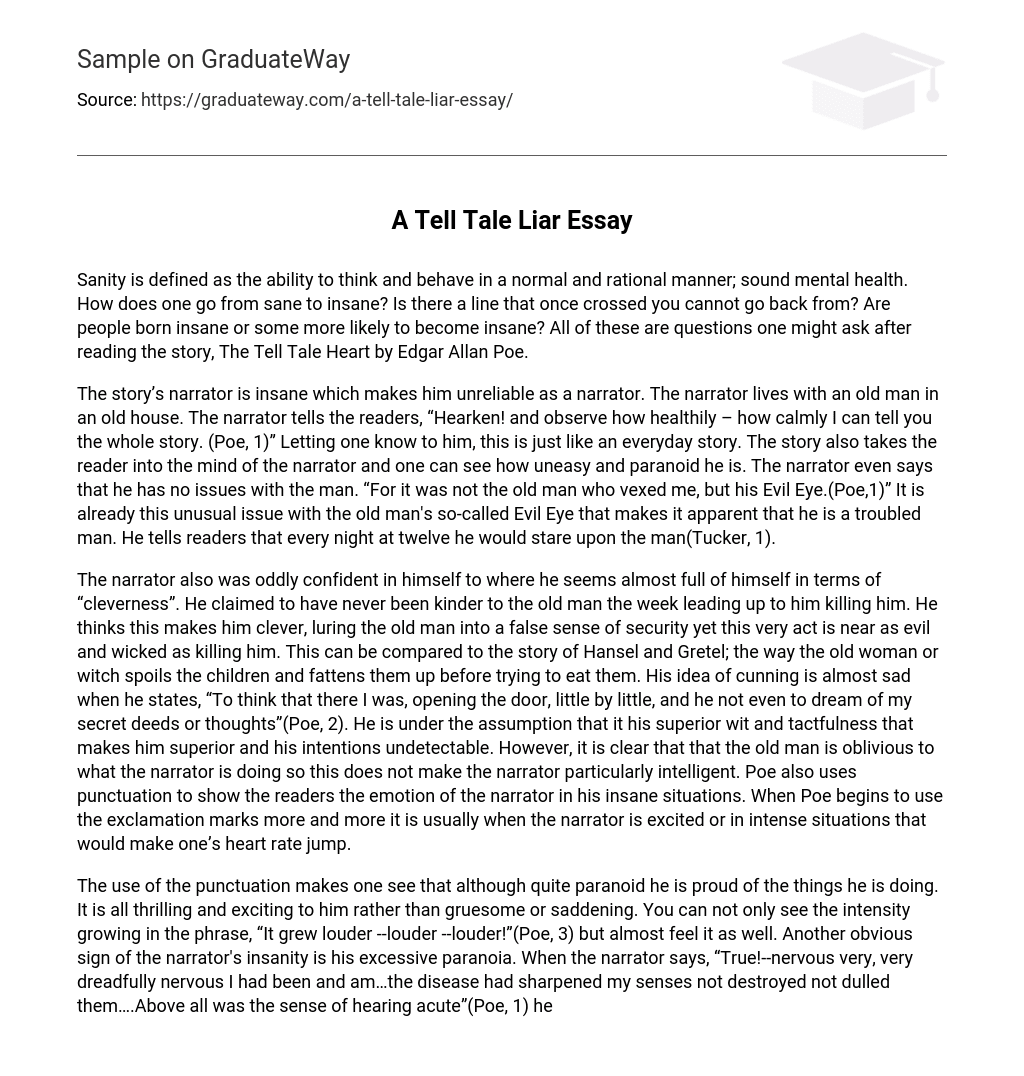Sanity is defined as the ability to think and behave in a normal and rational manner; sound mental health. How does one go from sane to insane? Is there a line that once crossed you cannot go back from? Are people born insane or some more likely to become insane? All of these are questions one might ask after reading the story, The Tell Tale Heart by Edgar Allan Poe.
The story’s narrator is insane which makes him unreliable as a narrator. The narrator lives with an old man in an old house. The narrator tells the readers, “Hearken! and observe how healthily – how calmly I can tell you the whole story. (Poe, 1)” Letting one know to him, this is just like an everyday story. The story also takes the reader into the mind of the narrator and one can see how uneasy and paranoid he is. The narrator even says that he has no issues with the man. “For it was not the old man who vexed me, but his Evil Eye.(Poe,1)” It is already this unusual issue with the old man’s so-called Evil Eye that makes it apparent that he is a troubled man. He tells readers that every night at twelve he would stare upon the man(Tucker, 1).
The narrator also was oddly confident in himself to where he seems almost full of himself in terms of “cleverness”. He claimed to have never been kinder to the old man the week leading up to him killing him. He thinks this makes him clever, luring the old man into a false sense of security yet this very act is near as evil and wicked as killing him. This can be compared to the story of Hansel and Gretel; the way the old woman or witch spoils the children and fattens them up before trying to eat them. His idea of cunning is almost sad when he states, “To think that there I was, opening the door, little by little, and he not even to dream of my secret deeds or thoughts”(Poe, 2). He is under the assumption that it his superior wit and tactfulness that makes him superior and his intentions undetectable. However, it is clear that that the old man is oblivious to what the narrator is doing so this does not make the narrator particularly intelligent. Poe also uses punctuation to show the readers the emotion of the narrator in his insane situations. When Poe begins to use the exclamation marks more and more it is usually when the narrator is excited or in intense situations that would make one’s heart rate jump.
The use of the punctuation makes one see that although quite paranoid he is proud of the things he is doing. It is all thrilling and exciting to him rather than gruesome or saddening. You can not only see the intensity growing in the phrase, “It grew louder –louder –louder!”(Poe, 3) but almost feel it as well. Another obvious sign of the narrator’s insanity is his excessive paranoia. When the narrator says, “True!–nervous very, very dreadfully nervous I had been and am…the disease had sharpened my senses not destroyed not dulled them….Above all was the sense of hearing acute”(Poe, 1) he sounds crazy.
Paranoid people can be extremely and unhealthily observant to their surroundings and in this case, his surroundings were dark so his hearing was his strongest sense at the moment. The narrator’s encounter with the officers shows how his cockiness meets his paranoia and how both show his insanity. It would have simply been enough for the Narrator to tell the officers that the shriek was nothing as he already had them assured. He instead invites them in and caters to them right above where he put the body under the floorboards. This says a lot about the narrator’s mental state and the longer the officer are in the home the more paranoid he gets. He begins hearing things and starts talking rapidly as he is uneasy in the situation he put himself in. Him being this reckless in the situation is a foil to how he characterized himself bore about his cunning. One can see that the narrator is neither clever nor sane. Why would a sane man have to repeatedly say that he is sane? With this conclusion, it is evident the narrator is unreliable because of his lack of sanity.
Works Cited
- Poe,Edgar Allan. ‘ The Tell Tale Heart ‘, Classic Shorts http://www.eastoftheweb.com/short-stories/UBooks/TelTal.shtml. Accessed 22 Feb. 2019.
- Tucker, and B. D. “‘The Tell-Tale Heart’ and the ‘Evil Eye.’” List of Books and Articles about Euthanasia | Online Research Library: Questia, National Association of Social Workers, 22 Mar. 1981, www.questia.com/library/journal/1G1-131896815/the-tell-tale-heart-and-the-evil-eye. Accessed 22 Feb 2019.





